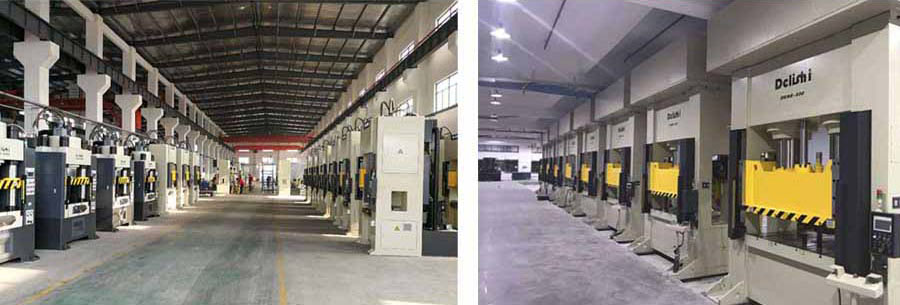Common Faults and Troubleshooting Methods of Hydraulic Press Machine
Hydraulic press machines are widely used in the pressing process of plastic materials. Such as extrusion metal forming, sheet drawing, transverse pressing, bending pressing, straightening and other processes. The common faults of hydraulic systems are relatively precise components. The fault point is not only hidden and difficult to determine, but also the cause is complex and difficult to judge. Four-column hydraulic presses are widely used in automobile manufacturing enterprises because of their many advantages. However, the frequent system failures of hydraulic equipment often affect the normal use of the machine and directly affect the production efficiency of the enterprise. In order to ensure that the production and operation of the enterprise are not affected, it is necessary to ensure that the hydraulic system of the four-column hydraulic press has good technical performance and normal operation. very important subject. Hydraulic Ren has sorted out 3 common faults and troubleshooting methods:

There are three basic "pathogenic" factors in hydraulic systems: oil overheating, air entering the system, and oil contamination. Practice has proved that 75% of the "diseases" of the hydraulic system are caused by these three reasons.
1. The oil temperature is overheated.
Hydraulic oil is the working medium of the hydraulic transmission system, which is generally suitable between 35°C and 60°C. If the oil temperature is overheated, it will not only destroy the viscosity of the oil, but also make the lubricating oil film thinner, resulting in a decrease in the working efficiency of the hydraulic system and serious leakage; it will also increase mechanical wear, destroy the normal matching clearance of each component, and cause the pump and valve matching surface Serious wear, increased frictional resistance, stuck valve core, resulting in equipment not working properly. At the same time, overheating of oil temperature will cause oil vaporization, water evaporation and cavitation of hydraulic components, resulting in the failure of the hydraulic system to work properly. In addition, overheating of the oil temperature will accelerate the aging of the rubber seal, greatly shorten its life, and even lose its sealing performance, resulting in serious leakage of the hydraulic system.
2. The hydraulic system is mixed with air.
The mixing of air into the hydraulic system will cause the hydraulic actuator to move erratically, cause air corrosion and dry friction to the hydraulic components, shorten the service life of the hydraulic components, and cause vibration, noise, and slide crawling in the pipeline and equipment.
3. The working oil is contaminated and deteriorated.
In the long-term harsh working site environment, impurities and dirt are easily mixed into the oil; when the contaminated hydraulic oil enters the pump and valve, it will scratch and destroy the precision and roughness of the mating surface, thereby increasing the leakage. At the same time, it will also cause the oil temperature to rise, resulting in insufficient pressure, unstable pressure holding, insensitive action of the actuator, and sliding blocks after parking.
Hydraulic System Faults and Troubleshooting Methods of Hydraulic Press Machine
1. The electromagnetic safety valve releases the pressure. The manual adjustment function cannot be adjusted to the rated pressure, the solenoid valve spool moves frequently, and the valve hole is worn, resulting in oil leakage from the control port of the relief valve, and the pressure cannot rise. The orifice of the main spool is blocked, so that the main spool can start to overflow at a lower pressure. The main valve core and valve seat hole are not well sealed, and there is oil leakage. The master cylinder pressure cannot rise because the solenoid valve is burned out, the spool valve block cannot be switched to the closed position, or the spool is stuck in the open position.
Method: Check and analyze the failure of each part of the safety valve, adjust the safety valve handwheel, adjust the pressure to 26MPa and lock the handwheel nut, control the gap between the valve core and the valve hole ≤ 0.008mm, clean the damping hole and all parts of the safety valve and keep it open. Replace the sealing ring between the main valve core and the valve seat hole, do not leak oil. If the solenoid valve coil is burned out, it should be replaced to ensure that the spool should be flexible during reversing and switching.
2. The spring of the main cylinder filling valve is broken, which makes the filling valve seal poorly.
Method: Replace the spring and grind the sealing surface of the filling valve to ensure no leakage.
3. The sealing ring of the main oil cylinder is worn, causing the pressure oil in the upper and lower chambers to communicate with each other.
Method: Replace the sealing ring. If the inner wall of the main cylinder is pulled, the ground should be repaired to prevent damage to the sealing ring.
4. The amount of oil in the fuel tank is insufficient, so that the suction port enters the air.
Exclusion: Hydraulic oil of the same grade should be added to exclude the air in the hydraulic system.
- Delishi Machinery Technology CO.,LTD.
- Add: No.3 JinFu Road, Jinma Industrial Park, LiaoBu town, DongGuan City, GuanDong Province, China.
- E-mail: info@goodsjack.com
- Tel: +86-769-83061993 / +86-13509801050
- Contact: Eva Lee
- E-mail: sales@goodsjack.com
评论
发表评论